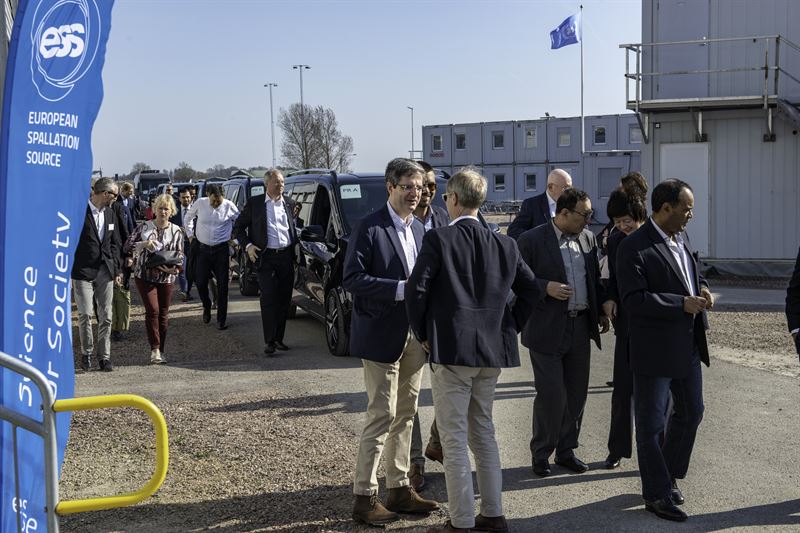Science for Society in focus at UN Security Council visit to ESS

Today, the United Nations (UN) Security Council visited the European Spallation Source (ESS) in Lund, Sweden, together with the Swedish Minister for Foreign Affairs, Margot Wallström. Lars Börjesson, Chair of the European Spallation Source ERIC Council, and John Womersley, ESS Director General, welcomed the delegation at the ESS Construction site.
The Ambassadors representing the 15 member countries of the United Nations Security Council visited ESS this afternoon during their three-day visit to Sweden. Margot Wallström, the Swedish Minister for Foreign Affairs, was pleased to introduce the prominent visitors to this European research infrastructure project, of which Sweden is the host country together with Denmark.
”We are proud to be able to show ESS to the Security Council,” said Margot Wallström. “We talked about technological development and global challenges, and how research and innovation can be used to meet today’s problems and crises.”
ESS, under construction in Lund, will be a multi-disciplinary research facility based on the world’s most powerful neutron source, providing unique research capabilities. The European Spallation Source ERIC (European Research Infrastructure Consortium) currently has 15 member- and observer nations, all committed to the goal of collectively building and operating this large-scale research infrastructure. Collaboration over borders is necessary to make this scientific endeavour a success, and ESS is being built through the collective global effort of hundreds of scientists and engineers in partner institutions all over the world. Once ESS opens for research, planned for 2023, up to 3,000 researchers will carry out scientific experiments at the facility every year.
“We’re honoured and pleased to host the UN Security Council today. ESS is a great example of international collaboration, with European nations pooling their resources to build the facility and staff members from no less than 50 countries,” saidESS Director General John Womersley. “But ESS is more than just a symbol of cooperation – this visit emphasises the key role that scientific and technical innovation must play in helping to addressing the world’s pressing challenges, from energy sustainability to healthcare to better use of materials.”
ESS Director General John Womersley introduced the UN Security Council representatives to the big science project ESS, focusing on its scientific benefits for society. The visitors also could see the progress of the construction work and learn more about the facility during a a guided tour of the Construction site. 2018 is a busy year at ESS with the peak of construction activities, as well as on-going installations in parts of the facility, in-kind deliveries from the member countries starting to arrive and the commissioning of the Ion Source.
Being one of the non-permanent members nations of the Security Council, Sweden is during the weekend the location for the Security Council’s yearly working meeting with the UN Secretary-General, António Guterres, a meeting which for the first time will take place outside the USA, at the farm Backåkra in Southern Sweden. Backåkra belonged to the former UN Secretary-General Dag Hammarskjöld, and is now used as a meeting place within areas such as international collaboration, environment, peace research and human rights.
For more information:
Julia Öberg, ESS Press Officer, 46 46 888 33 11 / 46 721 79 23 11 julia.oberg@esss.se
The European Spallation Source is a Partnership of European Nations committed to the goal of collectively building and operating the world's leading facility for research using neutrons.
Tags:



